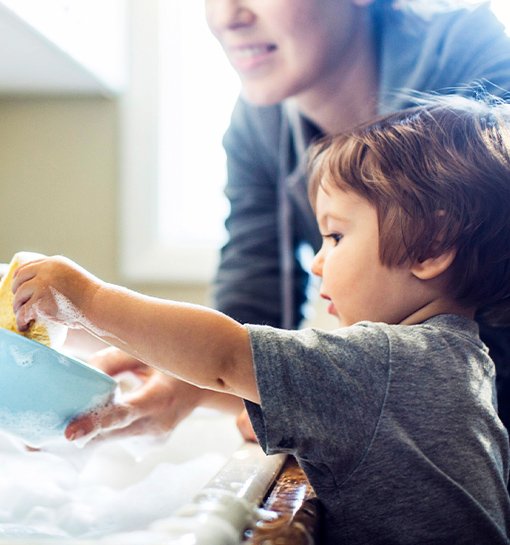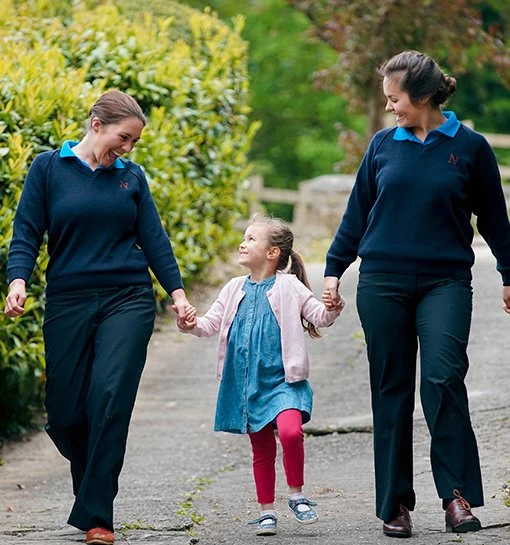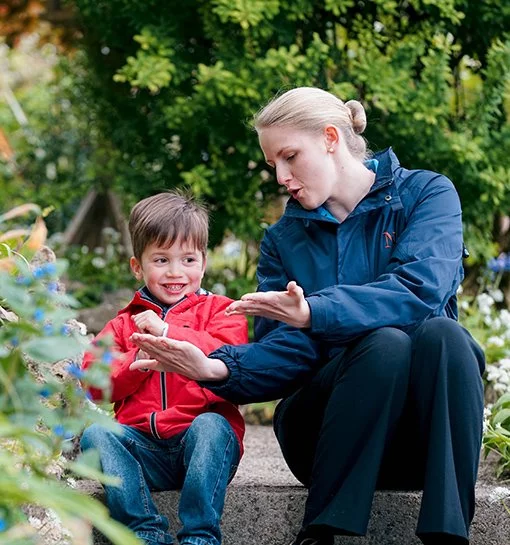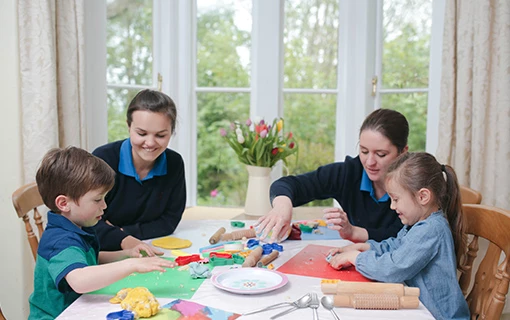Homebased activities part two: 22 more ideas for keeping your little (and big) ones busy
16 May 2020

If you are starting to run out of activity ideas or need some more inspiration, look no further. Lucy Rogers (Set 33), Newly Qualified Nanny (NQN) Consultant and a Norlander, has compiled 22 suggestions to help keep little ones entertained at home. Lucy has split these into morning and afternoon activities, to help you incorporate them into your day, but of course you can do these at any time to fit the natural rhythm of your child and what’s needed in the moment.
Before we start, a quick reminder. It’s important when we go out for exercise, and as lockdown restrictions ease, that children continue to understand the importance of washing their hands properly. It’s tricky to know sometimes whether older children are washing their hands when they have their own independence and privacy. This BBC CBeebies video showing how soap keeps germ away is a useful visual reminder that I would recommend showing toddlers, children and even teens. Singing while you wash your hands together is a helpful tip as children love catchy songs! Here’s a simple how to wash your hands song from the NHS or you could try making up your own words to your child’s favourite tune.

Fun activities for the morning
- Wake up and shake up! We are not moving about as much as we normally would, which is not good for us. Some schools run a daily morning wake-up activity to get children going and ready for the day ahead. Try out this wake-up dance by Out of the Ark at the start of your day and you are certain to end up with the song in your head by the end of the dance!
- Recreate PE lessons. Exercise is important both for our physical and mental health. Have a look online for a routine video that you can participate in together. The Body Coach Joe Wicks, for example, is running free PE classes from his YouTube channel on Mondays to Fridays at 9 am. Or try out one of the many child-led Zumba videos online together. I would highly recommend joining in as children really enjoy doing this with adults, and if you are as uncoordinated as I am, then they will also find it very funny!
- “In every job that must be done there is an element of fun, you find the fun and snap, the job’s a game!” With many of us still at home, there are more chores that need doing and these should not just fall to one person to do. It is important to help each other out and know that not everything is going to be done for you. Sometimes it can be difficult to encourage children to tidy up or help out with chores. Try turning cleaning into a game or adding a fun element to it to inspire children to help out. For example, use fun music to dance to while cleaning, sing a clean-up song to a familiar tune, or race to see how quickly they can put all the toys away. Cleaning is a great way to get moving, so you can have fun cleaning up and exercising at the same time!
- Write a letter. Writing a letter is something that you don’t see very much, it is a lot easier to send a message, pick up the phone, facetime or email our friends and family. These are great ways to stay in touch with your family, but there is nothing like receiving a handwritten letter, it is so personal. Asking children to write a letter or draw a picture to send to a family, friend or neighbour will help them feel less alone during isolation. It is also a good way to get children to practice their letter formation or develop their fine motor skills by giving them a specific aim. If the child is too young, role model by writing it for them.
- Craft a picture with objects from your garden or local park. If you are lucky enough to have a garden or access to a park, get the children to go out and find some natural objects to create a picture, such as leaves, flower petals, small twigs and grass. Please be aware of any plants that are poisonous and keep an eye on your children. Once you have collected your objects you can arrange what you have collected to create a collage picture using child-friendly PVA glue. Seek inspiration from the artist Andy Goldsworthy and you’ll be surprised at what’s possible. If you can’t get outside, try creating a new picture from torn-up magazines or flyers.
- Homemade bread. Making soda bread is an easy baking activity to do with children, and you should have the ingredients in your cupboard. If you’re having difficulty getting hold of flour, you might find that wholemeal, spelt or rye flour is more readily available. Soda bread does not need yeast, which means it is easier and quicker to make. Children really enjoy baking and it is a good life skill. Learning to cook at an early age will help children gain confidence and prepare them for when they are older and having to fend for themselves as young adults. There are plenty of simple recipes online. I find this BBC Good Food recipe simple and easy to follow.
- Make a cotton bud picture. Try using cotton buds to create pictures with paint. You could draw an outline or cut out a shape for children to fill in, or you could trace letters for them to fill. Think about seasonal objects or a favourite animal or character from a book. Remember to keep a close eye on children using cotton buds. If you don’t have any cotton buds, you could always have a go at thumb printing.
- Meditation. Being able to relax is important during stressful times and it is a good technique for children to learn as it will help them in later life. It is good for adults too. Search for an online meditation exercise to try out together. Alternatively, there are many helpful free apps out there that can help guide children through meditation, for example, Calm, which offers a one-week free trial or Breathe Kids.
- Create a cosy corner. Create a cosy corner together where your children can have quiet time. We all need parts in the day where we can enjoy five minutes of peace. Try placing a sheet over a table to make a calming den, add a blanket, duvet, some cushions, and books and toys that can be played with quietly. Ask your children to select these items, explaining that this is a cosy corner for them to enjoy when they want to have some quiet time. Children love a place to hide and make their own; creating this space themselves will also help to spark their imagination and creativity.
- Express your artistic skills. Art is a great way to express yourself and relieve stress. Of course, you can get the colouring books out or paint and let your children express themselves. Or if you would like to turn it into an art lesson, you could look at different artists and choose one to try and recreate the pictures. Abstract art featuring bold, bright shapes of colour is fun to copy, or you could have a go at trying to create your own picture in the style of the artist.
- Today’s the day the teddy bears have their picnic. There is nothing better than a picnic lunch, especially if you can bring along your favourite cuddly friend or favourite toy. It doesn’t have to be sunny outside; it doesn’t even have to be outside, just get out the picnic rug and enjoy a picnic! Children can help to make sandwiches and set out the picnic spread head of time as part of the fun.
Fun activities for the afternoon
- Mud pies. If you are lucky enough to have a garden or a patio with some pots and soil, this is a great space to use where you can. I would advise appropriate clothing as this is traditional messy play! Take out some pots and spoons, collect some soil and hold a competition to see who can make the best natural mud pie. You can add bits of grass, leaves, twigs and stones. Depending on age, you will need to be careful that the mud pie or anything that goes in the mud pie doesn’t get eaten! This activity will get their creative juices flowing, and it is also a great sensory activity. You can talk about different textures and how it feels, which will help younger children with their language development. You could follow up this activity by making an edible mud pie or brownies!
- Band practice! For this activity you don’t need to have any instruments! It’s all about using your imagination and finding things around the house you can make noise with. So, get out the pots and pans, wooden spoons, tins, boxes, lunchboxes, plastic cups and so on. You could also have a go at making your own instruments from your recycling. Fill clean empty bottles with a little bit of rice or put some elastic bands across a tissue box or jar lid. Carefully glue some bottle caps on a folded piece of cardboard, and you have a castanet. See what you can make before getting the band together for a good old sing song! Play to the beat of the song, sing songs that you know and make up new songs!
- Make pizza. Pizza is really simple to make, and you’ll find a lot of the ingredients in your kitchen cupboards. There are plenty of recipes online. You can get really creative with your toppings, depending on what you have in the house, and you could use bread as your pizza base if you’ve run out of flour. If you’re feeling really creative or would like to extend this activity, you could make a pizza menu and pretend you’re going to a restaurant and use some money or make some pretend money and price the pizzas. You could use weighing the ingredients and counting money as a fun way to do maths.
- Can you floss it? Yes, you can! Learning a new dance move, or even learning a whole dance to a song, is great fun. There are lots of videos of dance crazes online that you can use for this, from the floss to the moon walk. If you want to try and limit the time spent looking at a screen, you could teach some old school simple dance moves of your own, such as the Macarena, YMCA, Cha-Cha Slide, 5-6-7-8, Las Ketchup, Eye of the Tiger, Gangnam Style, Cotton Eye Joe, Oops Upside Your Head, the Fast Food song, the Twist or the Mash Potato, and many more! My seven year-old nephew particularly enjoyed learning all the dance moves to Eye of the Tiger, and then he taught the moves to the rest of the family. We all had great fun doing it and he loved being the teacher! Dance is a fun way to exercise and release those all-important endorphins.
- Story time. Story time is lovely time where you can cuddle up with your children’s favourite stories and spend quality time together. Stories can help expand your child’s vocabulary, interests, imagination, develop literacy skills and many more developmental areas depending on what you are reading.
- Spa time. Self-care is important and is a great way to relax and unwind from the stresses of everyday life. This is a useful calming and bonding activity ahead of bedtime, or you could add it to your bath time routine. All you need is some hand or body cream. Then you can rub it into their hands or feet if they want you to. You can talk about the different smells and describe the texture of different lotions, and then ask them to choose the one they’d like to use. You could take turns brushing each other’s hair or use different items in the house to gently brush their skin, such as a clean makeup brush or a soft toy. Ask them to describe how it feels, soft, tickly etc. Let them gently brush your skin as well.
- Make a papier mâché bowl. All you need for this activity is newspaper or paper along with a mug of plain flour and a mug of water… and that’s it! Simply tear your paper into strips, soak in the flour and water mix, then create your masterpiece. Once it has fully dried you can paint it. Then you can fill it with bits and bobs. If you are feeling really creative, you could make some masks using a bowl or balloon as a mould.
- Bake some scones. Scones are easy to make and will use up some staples you might have, such as soured milk. You may not have clotted cream, but a warm scone from the oven with a bit of jam is a lovely afternoon teatime treat. If you want to avoid sugar, try out a savoury scone recipe with cheese or herbs instead. These are delicious warm with a little bit of butter. Weighing the ingredients helps with numeracy, and everyone can get involved rubbing the butter in, stirring to make the dough and then cutting out the scones with different dough cutter shapes.
- Create a home cinema. Putting on a film is a nice way to spend some quiet time together. A film normally lasts an hour and a half which means that you can sit down with your children and rest too. To further this activity, the children could make cinema tickets, you could pop some popcorn or prepare a different snack together for your cinema experience, for example, fruit kebabs, homemade lollies, cupcakes, vegetable sticks and dip. Don’t forget to talk about what happened in the film afterwards together to help with language development or ask the children to draw pictures of the characters afterwards, to extend the activity.
- Kim’s game. For this game you need to find lots of random objects from around the house and put them on a table or tray. Give your child one minute to memorise all the objects before covering them up. Then spend another minute trying to remember as many objects as you can. For younger children, use fewer objects. For older children, add more objects to make it trickier.
- A similar game that doesn’t require objects is ‘I went to the shops and I bought a…’. For this game, each player has to come up with an object or food that they bought from the shops using each letter of the alphabet. The first person will say ‘I went to the shops and bought an apple.’ Then the person has to repeat everything the last person says and add their own, for example ‘I went to the shops and I bought an apple and a banana.’ Take it in turns working your way through the alphabet until you get to z. The longer this game goes on the harder it is to remember all the items that came before!
- Make up a story bag. For this activity you will need to choose some random objects and put them in a bag or box. Then make up a story by pulling each object out of the bag. For example, you could have small world characters and other toys. The story could be ‘Once upon a time there was a little girl who found a magical key that led her to a secret kingdom where she found a talking unicorn…’ Or you could collect some objects that link to a story and make a story sack. You could also try making story stones by finding and cleaning some large, smooth stones or pebbles and drawing simple pictures on them. Then draw these out of a bag one by one as you create your story (be careful if using with younger children as these could be choking hazards).








